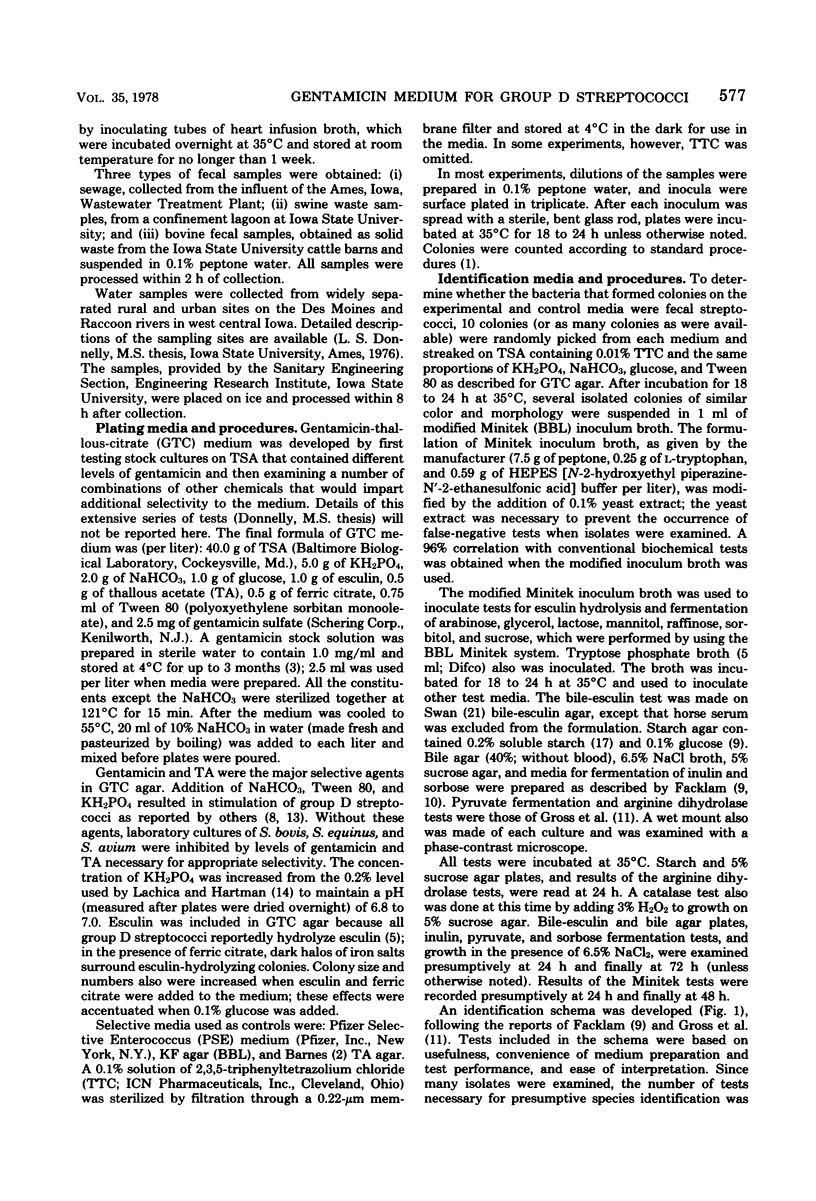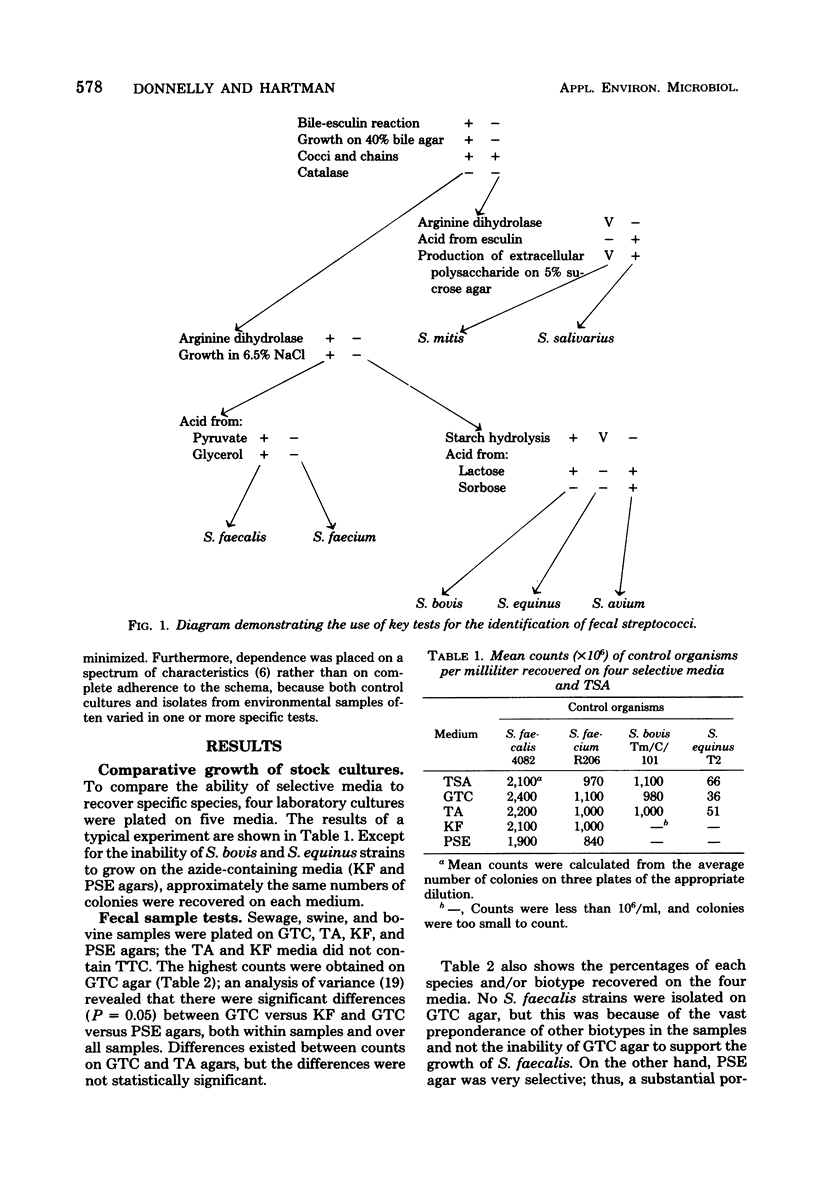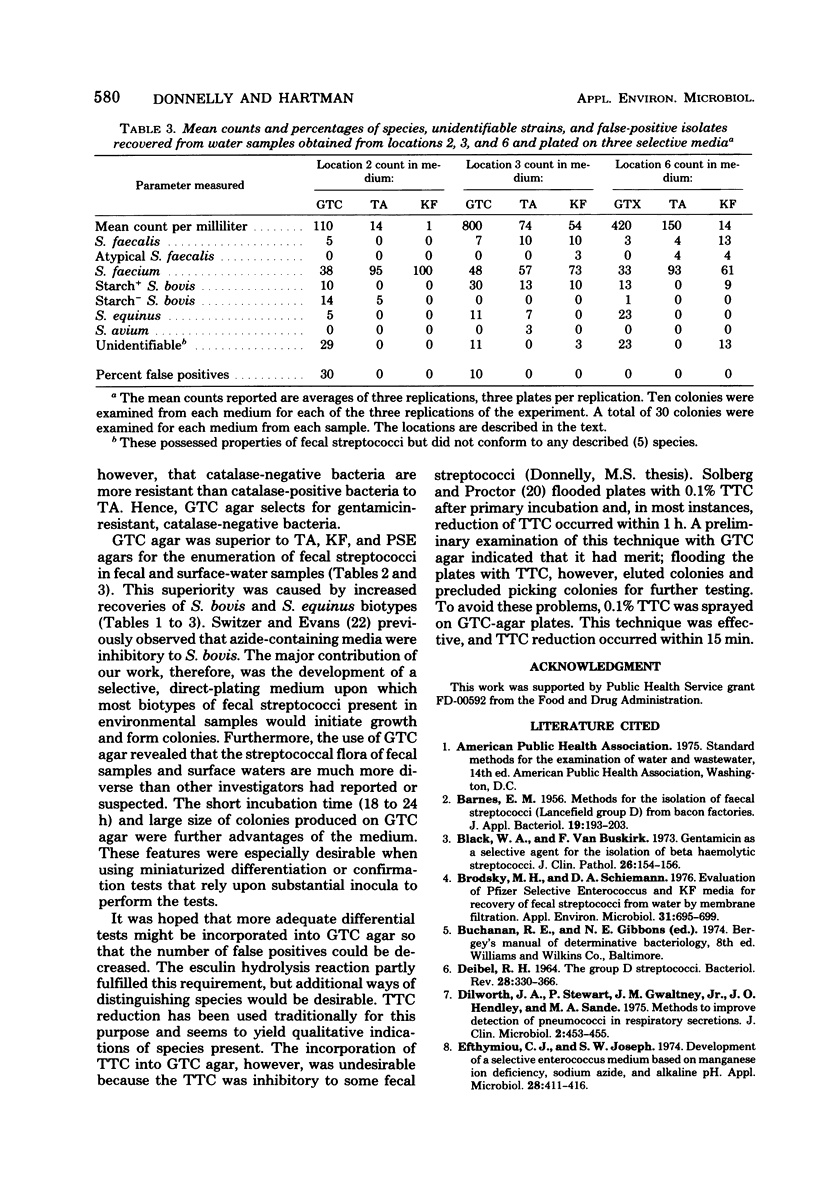Abstract
Gentamicin-thallous-carbonate (GTC) medium contained (per liter): 40.0 g of Trypticase soy agar, 5.0 g of KH2PO4, 2.0 g of NaHCO2, 1.0 g of glucose, 1.0 g of esculin, 0.5 g of thallous acetate (TA), 0.5 g of ferric citrate, 0.75 ml of Tween 80, and 2.5 mg of gentamicin sulfate. The NaHCO3 (20 ml of a 10% solution that had been heated to boiling) was added after sterilization of the basal medium. The spread plate technique was used to compare GTC agar with Pfizer selective enterococcus, TA, and KF agars by using sewage as well as bovine and swine fecal samples. Significantly greater numbers of group D streptococci were recovered on GTC agar than on Pfizer selective enterococcus or KF agars, within and over all samples. Higher counts also were obtained on GTC than on TA agar, but the differences were not statistically significant. The percentage of false positives was about the same for all four media. Samples of riverwater also were plated on GTC, TA, and KF agars, and significantly higher recoveries were obtained with GTC agar. GTC agar was superior to the other media examined primarily because of increased recoveries of Streptococcus bovis and S. equinus; other advantages of GTC agar were large colony size and short (24-h) incubation period. The percentage of false positives from riverwater was 13% for GTC agar and 0% for TA and KF agars; therefore, confirmation would be necessary when GTC agar is used with some types of environmental samples.
Full text
PDF





Selected References
These references are in PubMed. This may not be the complete list of references from this article.
- Black W. A., Van Buskirk F. Gentamicin as a selective agent for the isolation of beta haemolytic streptococci. J Clin Pathol. 1973 Feb;26(2):154–156. doi: 10.1136/jcp.26.2.154. [DOI] [PMC free article] [PubMed] [Google Scholar]
- Brodsky M. H., Schiemann D. A. Evaluation of Pfizer selective enterococcus and KF media for recovery of fecal streptococci from water by membrane filtration. Appl Environ Microbiol. 1976 May;31(5):695–699. doi: 10.1128/aem.31.5.695-699.1976. [DOI] [PMC free article] [PubMed] [Google Scholar]
- DEIBEL R. H. THE GROUP D STREPTOCOCCI. Bacteriol Rev. 1964 Sep;28:330–366. doi: 10.1128/br.28.3.330-366.1964. [DOI] [PMC free article] [PubMed] [Google Scholar]
- Dilworth J. A., Stewart P., Gwaltney J. M., Jr, Hendley J. O., Sande M. A. Methods to improve detection of pneumococci in respiratory secretions. J Clin Microbiol. 1975 Nov;2(5):453–455. doi: 10.1128/jcm.2.5.453-455.1975. [DOI] [PMC free article] [PubMed] [Google Scholar]
- Efthymiou C. J., Joseph S. W. Development of a selective enterococcus medium based on manganese ion deficiency, sodium azide, and alkaline pH. Appl Microbiol. 1974 Sep;28(3):411–416. doi: 10.1128/am.28.3.411-416.1974. [DOI] [PMC free article] [PubMed] [Google Scholar]
- Facklam R. R. Comparison of several laboratory media for presumptive identification of enterococci and group D streptococci. Appl Microbiol. 1973 Aug;26(2):138–145. doi: 10.1128/am.26.2.138-145.1973. [DOI] [PMC free article] [PubMed] [Google Scholar]
- Facklam R. R. Recognition of group D streptococcal species of human origin by biochemical and physiological tests. Appl Microbiol. 1972 Jun;23(6):1131–1139. doi: 10.1128/am.23.6.1131-1139.1972. [DOI] [PMC free article] [PubMed] [Google Scholar]
- Gross K. C., Houghton M. P., Senterfit L. B. Presumptive speciation of Streptococcus bovis and other group D streptococci from human sources by using arginine and pyruvate tests. J Clin Microbiol. 1975 Jan;1(1):54–60. doi: 10.1128/jcm.1.1.54-60.1975. [DOI] [PMC free article] [PubMed] [Google Scholar]
- Hartman P. A., Reinbold G. W., Saraswat D. S. Media and methods for isolation and enumeration of the enterococci. Adv Appl Microbiol. 1966;8:253–289. [PubMed] [Google Scholar]
- KENNER B. A., CLARK H. F., KABLER P. W. Fecal Streptococci. II. Quantification of Streptococci in feces. Am J Public Health Nations Health. 1960 Oct;50:1553–1559. doi: 10.2105/ajph.50.10.1553. [DOI] [PMC free article] [PubMed] [Google Scholar]
- Lachica R. V., Hartman P. A. Two improved media for isolating and enumerating enterococci in certain frozen foods. J Appl Bacteriol. 1968 Mar;31(1):151–156. doi: 10.1111/j.1365-2672.1968.tb00352.x. [DOI] [PubMed] [Google Scholar]
- Moellering R. C., Jr, Wennersten C., Weinberg A. N. Studies on antibiotic synergism against enterococci. I. Bacteriologic studies. J Lab Clin Med. 1971 May;77(5):821–828. [PubMed] [Google Scholar]
- Pavlova M. T., Brezenski F. T., Litsky W. Evaluation of various media for isolation, enumeration and identification of fecal streptococci from natural sources. Health Lab Sci. 1972 Oct;9(4):289–298. [PubMed] [Google Scholar]
- Pavlova M. T., Litsky W., Francis F. J. A comparative study of starch hydrolysis by fecal streptococci employing plate and tube techniques. Health Lab Sci. 1971 Apr;8(2):67–74. [PubMed] [Google Scholar]
- SWAN A. The use of a bile-aesculin medium and of Maxted's technique of Lancefield grouping in the identification of enterococci (group D streptococci). J Clin Pathol. 1954 May;7(2):160–163. doi: 10.1136/jcp.7.2.160. [DOI] [PMC free article] [PubMed] [Google Scholar]
- Sabbaj J., Sutter V. L., Finegold S. M. Comparison of selective media for isolation of presumptive group D streptococci from human feces. Appl Microbiol. 1971 Dec;22(6):1008–1011. doi: 10.1128/am.22.6.1008-1011.1971. [DOI] [PMC free article] [PubMed] [Google Scholar]
- Switzer R. E., Evans J. B. Evaluation of selective media for enumeration of group D streptococci in bovine feces. Appl Microbiol. 1974 Dec;28(6):1086–1087. doi: 10.1128/am.28.6.1086-1087.1974. [DOI] [PMC free article] [PubMed] [Google Scholar]


